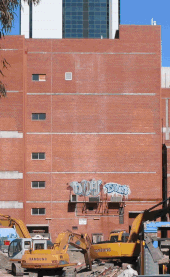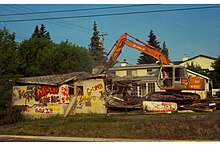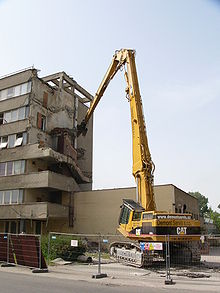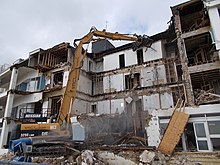Demolition





Demolition(also known asrazing,cartage,andwrecking) is thescienceandengineeringin safely and efficiently tearing downbuildingsand other artificialstructures.Demolition contrasts withdeconstruction,which involves taking a building apart while carefully preserving valuable elements forreusepurposes.
For small buildings, such ashouses,that are only two or three stories high, demolition is a rather simple process. The building is pulled down either manually or mechanically using large hydraulic equipment: elevated work platforms, cranes,excavatorsorbulldozers.Larger buildings may require the use of awrecking ball,a heavy weight on a cable that is swung by acraneinto the side of the buildings. Wrecking balls are especially effective against masonry, but are less easily controlled and often less efficient than other methods. Newer methods may use rotational hydraulic shears and silencedrockbreakersattached to excavators to cut or break through wood, steel, and concrete. The use of shears is especially common when flame cutting would be dangerous.
The tallest planned demolition of a building was the 52-storey270 Park AvenueinNew York City,which was built in 1960 and torn down in 2019–2021 to be replaced by270 Park Avenue.[1]
Manual[edit]





Before any demolition activities can take place, there are many steps that must be carried out beforehand, including performingasbestos abatement,removing hazardous or regulated materials, obtaining necessary permits, submitting necessary notifications, disconnecting utilities, rodent baiting and the development of site-specific safety and work plans.
The typical razing of a building is accomplished as follows:
- Hydraulic excavators may be used to topple one- or two-story buildings by an undermining process. The strategy is to undermine the building while controlling the manner and direction in which it falls.
- The demolition project manager/supervisor will determine where undermining is necessary so that a building is pulled in the desired manner and direction.
- The walls are typically undermined at a building's base, but this is not always the case if the building design dictates otherwise. Safety and cleanup considerations are also taken into account in determining how the building is undermined and ultimately demolished.
In some cases a crane with awrecking ballis used to demolish the structure down to a certain manageable height. At that point undermining takes place as described above. However, crane mounted demolition balls are rarely used within demolition due to the uncontrollable nature of the swinging ball and the safety implications associated.
High reach demolition excavators are more often used for tall buildings where explosive demolition is not appropriate or possible. Excavators with shear attachments are typically used to dismantle steel structural elements. Hydraulic hammers are often used for concrete structures and concrete processing attachments are used to crush concrete to a manageable size, and to remove reinforcing steel. For tall concrete buildings, where neither explosive nor high reach demolition with an excavator is safe or practical, the "inside-out" method is used, whereby remotely operated mini-excavators demolish the building from the inside, whilst maintaining the outer walls of the building as a scaffolding, as each floor is demolished.
To control dust, fire hoses are used to maintain a wet demolition. Hoses may be held by workers, secured in fixed location, or attached to lifts to gain elevation.
Loaders or bulldozers may also be used to demolish a building. They are typically equipped with "rakes" (thick pieces of steel that could be an I-beam or tube) that are used to ram building walls. Skid loaders and loaders will also be used to take materials out and sort steel.
The technique of Vérinage is used in France to weaken and buckle the supports of central floors promoting the collapse of the top part of a building onto the bottom resulting in a rapid, symmetrical, collapse.[2]
The Japanese companyKajima Constructionhas developed a new method of demolishing buildings which involves using computer-controlledhydraulic jacksto support the bottom floor as the supporting columns are removed. The floor is lowered and this process is repeated for each floor. This technique is safer and more environmentally friendly, and is useful in areas of highpopulation density.[3]
To demolish bridges,hoe ramsare typically used to remove the concrete road deck and piers, while hydraulic shears are used to remove the bridge'sstructural steel.

Fred Dibnahused a manual method of demolition to remove industrial chimneys in Great Britain. He cut an ingress at the base of the chimney—supporting the brickwork with wooden props—and then burning away the props so that the chimney fell, using no explosives and usually hand-operated power tools.[4]
Building implosion[edit]


Large buildings, tallchimneys,smokestacks,bridges, and increasingly some smaller structures may be destroyed by building implosion usingexplosives.Imploding a structure is very fast—the collapse itself only takes seconds—and an expert can ensure that the structure falls into its own footprint, so as not to damage neighboring structures. This is essential for tall structures in dense urban areas.
Any error can be disastrous, however, and some demolitions have failed, severely damaging neighboring structures. One significant danger is from flying debris, which, when improperly prepared for, can kill onlookers.
Another dangerous scenario is the partial failure of an attempted implosion. When a building fails to collapse completely the structure may be unstable, tilting at a dangerous angle, and filled with un-detonated but still primed explosives, making it difficult for workers to approach safely.
A third danger comes from air overpressure that occurs during the implosion. If the sky is clear, theshock wave,a wave of energy and sound, travels upwards and disperses, but if cloud coverage is low, the shock wave can travel outwards, breaking windows or causing other damage to surrounding buildings.[5]
Controlled implosion, being spectacular, is the method that the general public often thinks of when discussing demolition; however, it can be dangerous and is only used as a last resort when other methods are impractical or too costly. The destruction of large buildings has become increasingly common as the massivehousing projectsof the 1960s and 1970s are being leveled around the world. At 439 feet (134 m) and 2,200,000 square feet (200,000 m2), theJ. L. Hudson Department Store and Additionis the tallest steel framed building and largest single structure everimploded.[6]
Preparation[edit]
This section mayrequirecleanupto meet Wikipedia'squality standards.The specific problem is:Phrased as facts but not necessarily true in all cases of implosion. Some information not specific to implosion.(November 2023) |
It takes several weeks or months to prepare a building for implosion. All items of value, such as copper wiring, are stripped from a building. Some materials must be removed, such asglassthat can form deadly projectiles, and insulation that can scatter over a wide area. Non-load bearing partitions anddrywallare removed.[7]Selected columns on floors where explosives will be set are drilled andhigh explosivessuch asnitroglycerin,TNT,RDX,or C4 are placed in the holes. Smaller columns and walls are wrapped indetonating cord.The goal is to use as little explosive as possible so that the structure will fail in aprogressive collapse,and therefore only a few floors are rigged with explosives, so that it is safer due to fewer explosives, and costs less. The areas with explosives are covered in thickgeotextilefabric and fencing to absorb flying debris.[7]Far more time-consuming than the demolition itself is the clean-up of the site, as the debris is loaded into trucks and hauled away.
Deconstruction[edit]
An alternative approach to demolition is the deconstruction of a building with the goal of minimizing the amount of materials going tolandfills.This "green" approach is applied by removing the materials by type material and segregating them for reuse orrecycling.With proper planning this approach has resulted in landfill diversion rates that exceed 90% of an entire building and its contents in some cases. It also vastly reduces theCO2emissionsof the removing of a building in comparison to demolition.[8]
The development of plant and equipment has allowed for the easier segregation ofdemolition wastetypes on site and the reuse within the construction of the replacement building. On site crushers allow the demolished concrete to be reused as type 1 crushed aggregate either as a piling mat for ground stabilization or as aggregate in the mi xing of concrete.
Timber waste can be shredded using specialist timber shredders and composted, or used to form manufactured timber boards, such asMDForchipboard.
Safety is paramount; a site safety officer is usually assigned to each project to enforce all safety rules and regulations.
Teardowns[edit]
In real estate, a teardown or knockdown - also derisively called "bash and build" - is a term for demolishing a building immediately after purchasing it, freeing up the land for a new, typically larger building. The term first entered the real estate lexicon in the 1990s. A teardown is often done when the redevelopment value of a plot of land exceeds the value of the existing building. In the 2000s, teardowns by wealthybaby boomersreplacing houses across America with outsizedMcMansionsbecame so common that municipal building codes in many areas were revised, putting up more barriers to tearing down an existing homes.[9]
Teardowns are often cheaper than restoring an existing, dilapidated building, but can diminish historical value due to the more generic, cookie-cutter appearance of new houses and buildings compared to antique ones. Sometimes, saving the older building can still be viable if the owner spends more money to restore it. Purposely ignoring issues with a building in order to force demolition for public safety reasons is known as "demolition by neglect". "Canyon effect" is a term used to describe when smaller houses are surrounded by new, multi-story buildings with blank walls.[9]
See also[edit]
- Construction waste– Unwanted material produced directly or incidentally by the construction industries
- Demolition waste– Waste debris from destruction of buildings, roads, bridges, or other structures
- House demolition– Military tactic (military tactic)
- ICE demolition protocol
- List of demolished buildings and structures in London
- National Federation of Demolition Contractors(UK)
- Slighting– Damage of buildings to reduce their value
- Urban renewal– Land redevelopment in cities
References[edit]
- ^https:// newyorkyimby /2017/09/270-park-avenues-shrouded-demolition-making-progress-in-midtown-east.html[dead link]
- ^"HD_20h_20070822_chunk_2 – Vidéo Dailymotion".Dailymotion. 23 August 2007.Retrieved6 May2012.
- ^"Kajima Demolition Tech".Popular Science. December 2008.Retrieved18 November2008.
- ^Hall, David (2006).Fred.Bantam Press. pp. 66–68.ISBN0-593-05664-7.
- ^Cultice, Curtice (1997)."Blasting a path to world markets".BNET Business Network.Retrieved19 May2008.
- ^"J.L. Hudson Department Store".Controlled Demolition, Inc. Archived fromthe originalon 20 December 2008.Retrieved20 October2006.
- ^abWGBH Boston(December 1996)."Interview with Stacey Loizeaux".NOVA Online.Public Broadcasting Service.Retrieved29 April2009.
She learned the fine art of demolition from her father, Mark Loizeaux, and her uncle, Doug Loizeaux—president and vice-president of the company. NOVA spoke with Ms. Loizeaux a few days before Christmas, 1996.
- ^"Taisei Corporation's Tecorep reducing CO2emissions by 85% ".Archived fromthe originalon 15 April 2016.Retrieved26 August2017.
- ^abHiggins, Michelle (16 June 2006)."The Teardown Wars".The New York Times.ISSN0362-4331.Retrieved13 July2024.
External links[edit]
 Media related toDemolitionat Wikimedia Commons
Media related toDemolitionat Wikimedia Commons The dictionary definition ofdemolitionat Wiktionary
The dictionary definition ofdemolitionat Wiktionary

